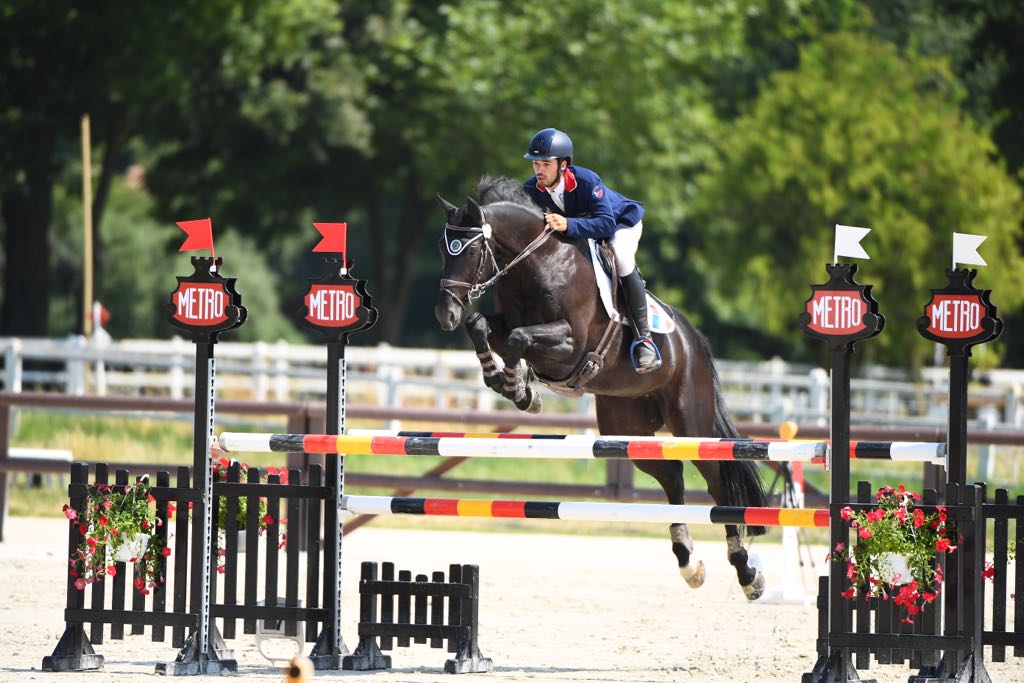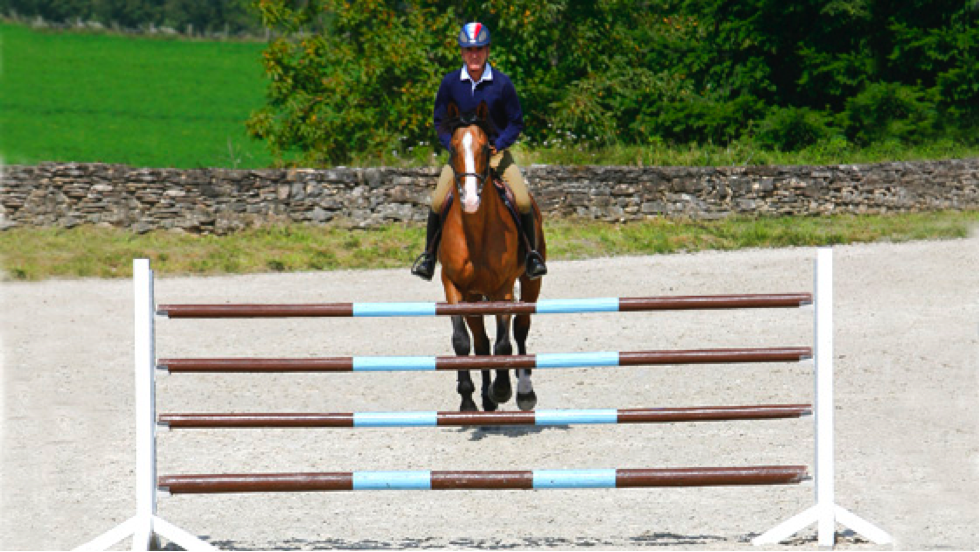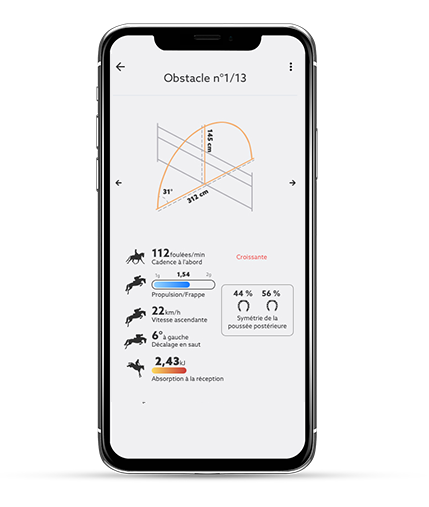Friday, November 23, 2018
As you may have noticed, theSAUTS tab tab of your app has been enhanced with 7 new features. Now there's no excuse not to take care of your routes and your approaches jumping approaches. In this article, we give you the keys to understanding these brand-new features and their benefits for your jumping sessions.

In addition to jump height and take-off angle, we measure the following for each jump amplitudei.e. the distance between the landing of the hind legs at take-offand the forelegs on landing.
This distance from the ground gives you a better view of the trajectory of your horse's trajectory, so you can adapt it to your horse's needs and feel more at ease in combinations and other lines.

Of course, there's no such thing as a perfect value. depends on obstacles achievedand what you want. So, for a 1m vertical (the height measured by your Seaver strap will be around 115cm for an "ordinary" horse), we'll have a span of around 130cm, while it could exceed 250cm for a spa bar with the same dimensions.
In show jumping, on 160cm oxers we can easily reach 450cm, while on cross-country, a 130cm flight obstacle will bring trajectories to nearly 6m.
The regularity of stride when approaching an obstacle, and the absence of a break in rhythm, are important elements in the quality of the approach. We measure cadence on the 5 last strides (less in the case of close jumps), and also determine whether the cadence is stable, increasing or decreasing. decreasing on these last strides.
The figures are highly dependent on the model model and locomotion of the horse: a 1m70 horse with a large amplitude will often be comfortable in a canter cadence of around 100 strides/min, while a 1m40 pony will more often be in cadences of 120-130 strides/min.
Watch out for trotting approaches, which can lead to cadences that start out ... at a trot! The important thing is regularityWe may want to approach an obstacle at an increasing or decreasing cadence, depending on what we're working on. Note that it's all about evolution of cadenceand not the amplitude of the strides at the start. For example, we may have tackled an oxer with an "increasing" stride, i.e. covering a greater and greater distance with each stride, but with a decreasing cadence: each stride lasts longer and longer.

Source: Horse Academy
We calculate the stroke, i.e. the vertical acceleration deployed by the horse at the moment of the call, to fight against the earth's attraction and project itself over the obstacle. We measure this magnitude in g ("ge"), like the accelerations experienced by pilots when accelerating cars or rockets (1 g = 9.81 m/s2corresponds to the acceleration of gravity).
The stroke will always be between 1 g (the acceleration required to break away from gravity and lift off the ground) and 2 g (the limit observed for horses). The impact depends, of course, on the jump heightbut also on the explosiveness "of the horse. For jumps of around 1m, we typically find impact values of around 1,1 g à 1,2 g. For jumps of up to 1.60 m, we can reach 1,8 g or even more. For the same height of effort, we'll often have higher propulsion values for a vertical profile than for a wider obstacle.
The Seaver strap also measures the speed reached by the horse during the upward phase phase of the jump. This speed depends on the ground speed of the horse during l'approachbut also on the force he develops. It will typically be between 10km/h and 20km/h. We'll often see higher values at the jump-off, or on cross-country obstacles, and lower ones on vertical profiles.
A low upward speed may indicate a horse that takes its time to jump (this is positive), or on the contrary, a horse that "stops" in the air and doesn't function well. A high speed may correspond to a horse that throws itself and rushes, but also to a horse that uses its kinetic energy well on the ground to overcome difficulties. The rider's (or coach's) feeling is crucial in these cases.
 5. Jump offset
5. Jump offset We measure (in degrees of angle) the horse's offset during the jump, i.e. the difference between its orientation spatial orientation at approach and landing. This measurement in no way reflects perpendicularity to the bar: we can jump at an angle but keep our horse perfectly straight, just as we can have a horse that shifts sharply over one shoulder while we approach perpendicularly and in the middle of the obstacle.
The offset must be as low possible. The horse can be considered straight between 0 and 5°.. Above 10°the offset is high. The most important thing is to check whether this offset is constant. A horse that only shifts once in a session will have no problem on this side, whereas we'll be looking to find out more if his horse specifically shifts to one side on more than 50% of jumps. There are many reasons for this: an asymmetrical asymmetrical rider in his trimhis legs or handsan apprehension of the receptionpain pain or discomfort in a posterior or backor simply a natural asymmetry of the horse. A young horse will often move out of line simply because of a lack of straightness, but you should always try to minimize the amount of movement.
An asymmetrical asymmetrical is at the origin of the offset. We compare the thrust of the two hind legs here, to warn you if there is a large difference. Values between 45 % and 55 % for each hind leg are perfectly satisfactory. Below or above this level, you'll need to start watching your horse, especially if the phenomenon is repeated on more than half the jumps on the same side.
The "weak" hind leg is the one with the lowest percentage, i.e. the one on the side of the offset. Remember to keep a close eye on the weak hindquarters and the back if an asymmetry suddenly appears on a usually straight horse.
This value represents theenergy absorbed by the horse on landing an obstacle, mainly in the forelegs. It is measured in kilo Joules (kJ). The higher the value, the more energy the horse has dissipated by touching the ground. It's these repeated shocks that can cause joint problems or tendon problemsThe key is to minimize the amount of energy absorbed, by jumping lower, less often or fewer times per session.

Of course, it's also important to ensure that the ground is neither too hard nor too deep. In practice, among other parameters, the bigger the jump and the higher the impact, the greater the energy absorbed. For obstacles of1m we'll typically find values between 0.8kJ and 1.2kJwhile we'll exceed 4kJ for obstacles at 1m50 obstacles. Over the course of a session, we aim not to exceed 50kJ in total (i.e. about 50 small jumpsor a dozen big jumps).
For more information on our other features ⤵️
See you soon for a new article,
The Seaver team 😍